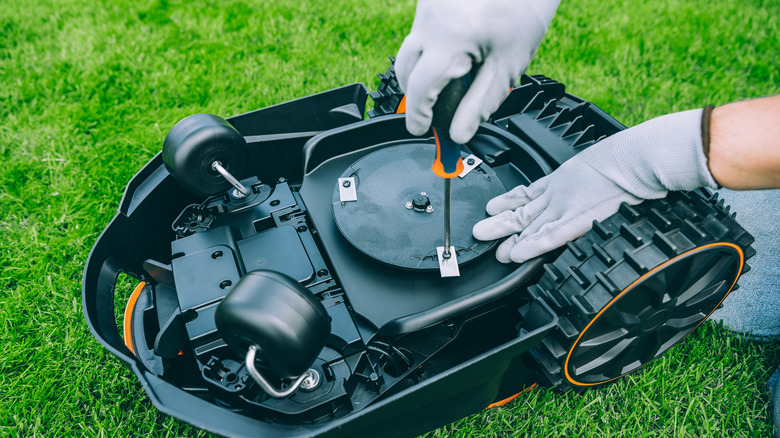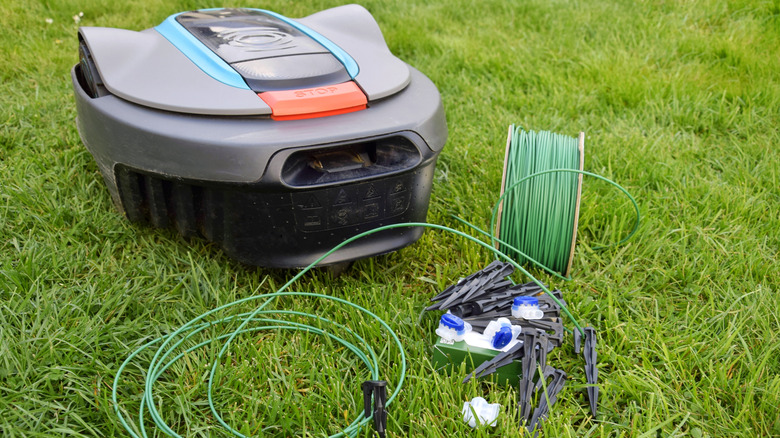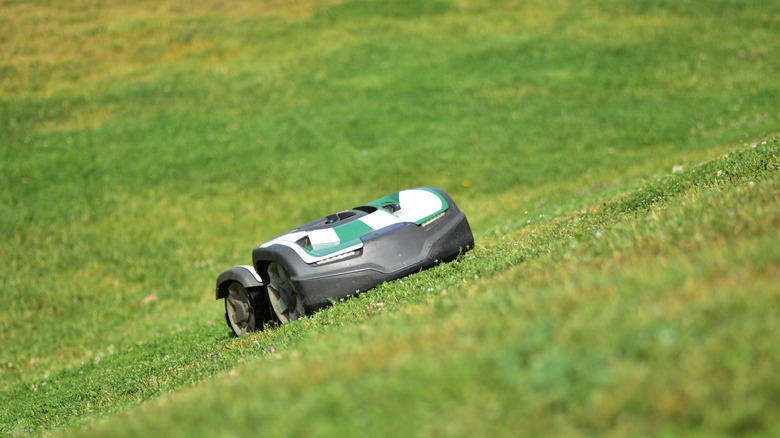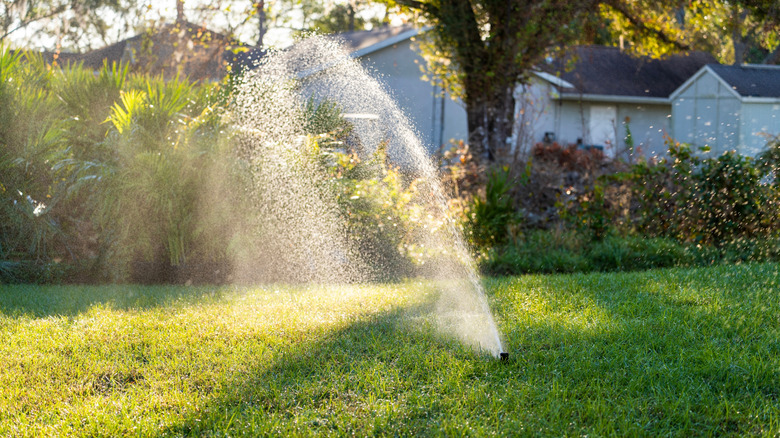5 Of The Biggest Mistakes You Can Make With Smart Lawn Mowers
Front lawns are closely associated with the American Dream, as for many they symbolize community, homeownership, and control. However, there's more to obtaining and keeping that coveted healthy close-cropped layout of grass than meets the eye. Behind every blade of grass standing proudly in formation, there's a story of diligent maintenance that goes untold, from the sheer time investment, to weed eating and mowing. Mowing can easily present itself as the most time-intensive activity of lawn care, and the science of keeping your lawn level and appealing can be rather complex.
Proposed as a means of saving hours of human effort, robotic mowers made their first appearance with the MowBot, in 1969. As technology evolved, these robots gained the "smart" label, but they didn't change much. Robot lawn mowers are actually pretty simple, but to make them even simpler: picture a Roomba, but it's cutting grass.
There are multiple benefits to leaving lawn maintenance to smart lawn mowers: long-term cost savings, reduced environmental pollution (both noise and carbon emissions), and most importantly, minimized labor. However, despite their numerous advantages, robot mowers, like any gadget, are prone to misuse. Complexities in installation and maintenance pose challenges to operating these devices optimally, and there's a learning curve that could take some getting used to. There's a whole list of things you should know before buying a robotic lawn mower, but here are the five biggest mistakes you could make when using one of those tools.
Improper or negligent maintenance
The importance of maintenance in machines with moving parts cannot be overstated, and robotic lawn mowers are no exception. With so many compartments and sensors to keep track of, it's easy to neglect a few when carrying out routine maintenance. One of the most common oversights is forgetting to clean the mower properly. However, without consistent cleaning, debris could cling to the cutting deck and hamper the mower's ability to level lawns effectively.
Cutting ability isn't the only variable affected by poor maintenance. Improper cleaning procedures lead to a gradual buildup of dirt in sensitive areas such as the wheels or chassis. That's bad news for the smart mower, as dirt lodged in the machine hampers its movement and increases power consumption. Even worse, if debris makes contact with the charger, it could cause the mower to stop charging entirely due to corrosion.
Beyond reduced performance and charging efficiency, negligent maintenance could damage the mower's sensors. Smart lawn mowers rely on sensors to navigate, and improper cleaning procedures can pose problems: stained sensors might not detect obstacles and boundaries, or, depending on the extent of the debris clutter, they could stop working entirely. To get the most out of your smart lawn mower, you should make sure to clean every component regularly.
Improper installation
The process of configuring smart lawn mowers varies depending on the model. Some may not need much assistance when setting them up, but the level of detail in others can be particularly involved. With some robotic mowers still using boundary wires, you may need to hire professional help to achieve a proper setup.
Boundary wires define the mower's operable perimeter, at least for the few models that still use them. An improper installation of these wires could see the device roam into unwanted areas, potentially causing damage to itself and its surroundings. Additionally, if the boundary wires are installed above-ground, they are prone to be damaged themselves. Exposure to harsh climate, stretching, or simply tripping on it can make the wire ineffective.
A growing number of robot mowers are circumventing the problem of wire installation by employing GPS, satellite, and sensor technology. However, even these are not immune to installation issues. The reliance on GPS and satellite connections in these models introduces variables such as network strength and direct line-of-sight. Installation protocols vary for each home and layout, and you need to consider the uniqueness of your lawn setup before making a purchase.
Not considering the layout of your lawn
Similar to installation procedures, which require you to consider home suitability, you can't use smart lawn mowers on just any layout. For instance, when used on lawns with uneven, rocky, or obstacle-heavy terrain, the blades are prone to wear. Worn blades give unsatisfactory cuts, which reduce the overall quality of your lawn. Sloped land could also pose a challenge for smart mowers in this regard. If your model can't make adequate cutting adjustments for steep angles of inclination, the blades could make improper contact with the ground, which will dull the edges over time. Movement is also a factor to consider; some layouts require you to physically carry the device for it to access certain areas.
Speaking of movement, lawn size plays a crucial role in the efficiency of smart mowers. Models configured for residential use typically cover between 0.2 and 1.5 acres of land. Using robot lawn mowers on lawns larger than their specifications demands frequent trips to the charging station. Such a setup not only elongates the device's operating time, but overcharging could cause the battery to deteriorate in the long term. For lawns larger than 1.5 acres, the Yarbo Mower Pro could suit your needs.
With this in mind, you might want to prep your yard before buying a smart lawn mower. Fill any holes, level uneven areas, and do your research on suitable mowers that support sloped or large yards.
Leaving all yard work to the mower
While smart lawn mowers save a lot of your yard work time, you'll still need to keep a close eye on things to give your lawn that sought-after pristine look. For a multitude of reasons — robot shape limitations, navigation system glitches, dirty sensors, or obstacles — even the best of smart mowers will inevitably miss spots in their operation.
Narrow grass patches can be problematic for robot mowers to cut, unless they are specifically designed to pass through tight spaces. Edging grass is another limitation, especially in areas bounded by fence lines or other obstacles. Additionally, sensors can malfunction for unforeseen reasons, and mowers might end up missing sections of grass entirely as a consequence.
There's also the question of handling leaves in the fall and winter. Some smart models can clean the litter, but if yours doesn't come with that functionality, you'll have to resume rake duty to clear the debris. Leaving lawn management entirely to smart lawn mowers isn't advised; there's still a fair bit of manual work to do to keep your lawn uniform and shiny.
Operating smart lawn mowers on wet grass and in bad weather
Although robot lawn mowers are durable when properly used and maintained, they don't perform well in harsh weather. While most are designed to be water-resistant, operating the robots during rain could damage their electrical components. Several models avoid damage from weather through the aid of rain sensors and weather detection systems, which send signals to return to the docking station till the poor weather clears. However, even if your mower has this option, you'll need to enable it in the settings.
Beyond direct exposure to the elements, water could pose a danger to smart mowers through wet grass. Wet grass creates more resistance than dry grass when mowing. This has two implications for your smart mower; The blades will struggle to properly trim your grass, and it will exert more force in trying to cut it. In this scenario, the blades could become dull over time, and the mower's battery will drain quickly.
There's also the factor of clogging to consider. Although most robot mowers employ a mulching system to cut and deposit chopped grass back on the lawn, wet grass can get stuck in the machine's deck. In the short-term, this could manifest in relatively minor inconveniences, such as the mower missing spots in its cutting route. However, over time, the robot can stop working altogether. It's generally considered a bad idea to mow wet grass, so you need to consider the climate when setting your smart lawn mower to work.





